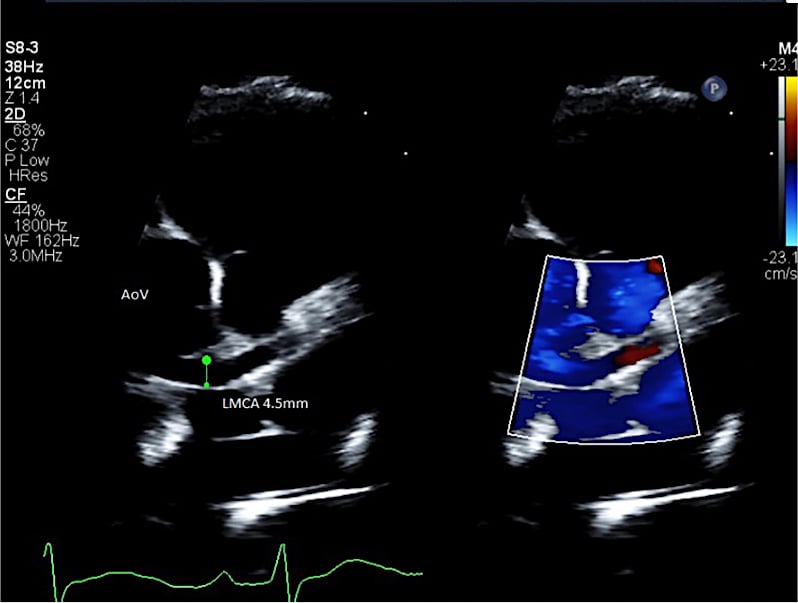
Exantham on abdomen and back of a pediatric patient at Nemours Children’s Health System in Delaware who presented with mysterious symptoms in what would later be identified as one of the first cases of multisystem inflammatory syndrome in children (MIS-C) in the United States. Find more images
September 14, 2020 – At the height of the COVID-19 (SAR-CoV-2) pandemic in April, a 14-year-old boy was admitted to the emergency department at Nemours Children’s Health System in Delaware with mysterious symptoms in what would later be identified as one of the first cases of multisystem inflammatory syndrome in children (MIS-C) in the United States. His care and retrospective diagnosis have been published in Progress in Pediatric Cardiology as a timely case study linking COVID-19 to the highly dangerous syndrome which is rare in children and causes inflammation of the heart, lungs and other vital organs.[1]
“There are lessons to be learned from this case, the most critical being to maintain your suspicion if there are several plausible diagnoses,” said Deepika Thacker, M.D., senior author of the paper and pediatric cardiologist with Nemours Children’s Health System. “This allowed us to remain vigilant and adapt treatment as we went, based on the signals and symptoms we were seeing.”
Prior to reports from Europe about similar cases in children, the patient presented to the emergency department with a four-day history of fever, fatigue and abdominal pain. He initially tested negative for COVID-19 and was admitted to the general pediatric ward. But his condition quickly deteriorated, with severe diarrhea, increasingly high fever and a quickly spreading rash that further escalated to chest pain, fluid in the lungs and decreasing heart function.
The seemingly unconnected presentation of symptoms made several diagnoses appear possible. While being treated in the cardiac intensive care unit, the patient had to be intubated and placed on mechanical ventilation. During his 12-day hospital stay, he was treated with penicillin, ceftriaxone, epinephrine, phenylephrine, milrinone, intravenous immune globulins, and high-dose aspirin to cover the wide variety of possible conditions. Only after discharge, an antibody test showed he had had COVID-19.
Based on the team’s experience with this patient and others, as well as data from other centers, Nemours’ physicians developed a clinical pathway for early recognition and treatment of MIS-C to speed the diagnosis and care of children with this new presentation of COVID-19.
“In the three months since this patient was in critical care, we have learned so much about diagnosing and treating this novel presentation of COVID-19 in children,” said Thacker. “This information-sharing has undoubtedly saved lives.”
This first patient recovered, as have all 15 patients treated with MIS-C at Nemours Children’s Health System in Delaware. Moving forward, the cardiology team will continue to follow up with patients who have experienced MIS-C for at least one year to understand the long-term impact of this acute condition.
VIDEO: Overview of Multisystem Inflammatory Syndrome in Children (MIS-C) in COVID-19 Exposed Children — Interview with Deepika Thacker, M.D.

Echocardiogram showing trivial dilation of left coronary artery. AoV: aortic valve; LMCA: left main coronary artery.
CDC Now Reports 800 U.S. Children Diagnosed With MIC-C
The Centers for Disease Control and Prevention (CDC) reported as of Sept. 10, 2020, there have been 792 confirmed cases in the United States of the rare MIS-C condition in children that is linked to COVID-19.
The agency also reported there have been 16 deaths reported from the MIS-C cases reported in 42 states, New York City and Washington, D.C., as of Sept. 3. Nearly all cases of MIS-C occurred in children who tested positive for the new coronavirus, while the remainder were in children who were around a person with COVID-19.
The CDC report also gave the following statistics:
• Most cases are in children between the ages of 1 and 14 years, with an average age of 8 years.
• Cases have occurred in children from <1 year old to 20 years old.
• More than 70% of reported cases have occurred in children who are Hispanic/Latino (276 cases) or non-Hispanic Black (230 cases).
• 99% of cases (783) tested positive for SARS CoV-2, the virus that causes COVID-19. The remaining 1% were around someone with COVID-19.
• Most children developed MIS-C 2-4 weeks after infection with SARS-CoV-2.
• Slightly more than half (54%) of reported cases were male.
Find additional CDC statistics on U.S. MIS-C cases
Additional MIS-C Information and Guidance on Testing and Treatment:
Related Content on MIS-C:
Kawasaki-like Inflammatory Disease Affects Children With COVID-19
VIDEO: Overview of Multisystem Inflammatory Syndrome in Children (MIS-C) in COVID-19 Exposed Children — Interview with Deepika Thacker, M.D.
NIH-funded Project Wants to Identify Children at Risk for MIS-C From COVID-19
New Study Looks at Post-COVID-19 Emerging Disease in Children
The Cardiovascular Impact of COVID-19


 November 12, 2025
November 12, 2025 









